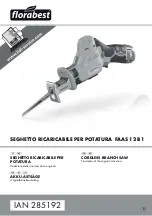
30
CHIP REMOVAL (Continued…)
Chip conveyor
1.
During operation, metal chips and used coolant
drop directly into a sloped trough, or flow into it
from the machine’s run‐off surfaces. Coolant then
flows down the trough and through a filtering
screen before returning to the reservoir.
2.
The chip conveyor motor operates simultaneously
with the hydraulic pump motor. The conveyor
auger rotates slowly at the bottom of the trough.
It’s movement carries metal chips to the opening at
the machine’s right side where chips empty into a
customer supplied container.
3.
A needle valve located below the auger allows the
chip auger motor to be adjusted for faster or slower
operation.
NESTING FIXTURE
1.
This feature is designed for high‐production,
multiple sawing of stacked bars, rounds and tubing.
2.
Vertical nesting clamp cylinders are mounted to the
machine’s fixed and index vises. The cylinders
operate simultaneously with the regular vise
clamping cylinders.
3.
Vise capacity depends on the machine model.
The hydraulic operated nesting fixture can also
be used with the variable vise pressure control.
Stacking stock
1.
Correct stock nesting is essential for proper
clamping of the vises and nesting fixture. It is
important that nesting vise clamping pressure be
transmitted to every stacked piece. Sometimes this
can be more easily accomplished by manually
jogging the stack.
2.
Proper stacking of round stock is important because
saw band breakage may occur if round nested
pieces slip or spin during sawing.
3.
There are two (2) workable round stock stacking
methods, either in equal rows (4 x 4 x 4) or nested
rows (4 x 3 x 4). The first provides the best sawing
results, although the second method can be used (if
the material is not stacked too high) and offers
better clamping when material has small diameter
differences.
4.
Pieces should be stacked as closely together as
possible. Metal chips lodged in the open spaces
between individual pieces will affect cutting accu‐
racy.
Vise adjustment
Nesting fixture vise adjustments.
1.
Stack stock to be cut between the machine’s vise
jaws. Then: (a) open the fixed and rear vises; (b) bolt
the supporting bar tightly to the fixed vise jaws, but
loose on the movable jaws.
2.
Loosen the screw on each side of the clamp bars
and position the clamp bars to fit the size of the
nested stock. Then adjust the index table’s vertical
guide rollers so the stock will be guided correctly
toward the saw band.
3.
The indexing vise has two positions to place the
nesting fixture.
Position A is the forward position on the index
vise.
Position B is the rear position of the nesting
fixture. See the chart below.
4.
The remnant will change depending on the position
of the nesting fixture. See the chart below:
C‐3028NC
C‐4033NC
C‐420NC
Position A
190
200
215
Position B
330
330
330
C‐5650NC
C‐560NC
Position A
215
N/A
Position B
375
N/A
Summary of Contents for C-3028NC Boxed
Page 2: ......
Page 3: ......
Page 11: ...6 MACHINE DIMENSIONS Continued C 3028NC DIMENSIONS...
Page 12: ...7 MACHINE DIMENSIONS Continued C 3028NC Boxed DIMENSIONS...
Page 13: ...8 MACHINE DIMENSIONS Continued C 4033NC DIMENSIONS...
Page 14: ...9 MACHINE DIMENSIONS Continued C 420NC DIMENSIONS...
Page 15: ...10 MACHINE DIMENSIONS Continued C 420NC BOXED DIMENSIONS...
Page 16: ...11 MACHINE DIMENSIONS Continued C 5650NC DIMENSIONS...
Page 17: ...12 MACHINE DIMENSIONS Continued C 560NC DIMENSIONS...
Page 18: ...13 MACHINE DIMENSIONS Continued C 6260NC DIMENSIONS...
Page 19: ...14 MACHINE FEATURES...
Page 39: ...34 LUBRICATION DIAGRAM...











































